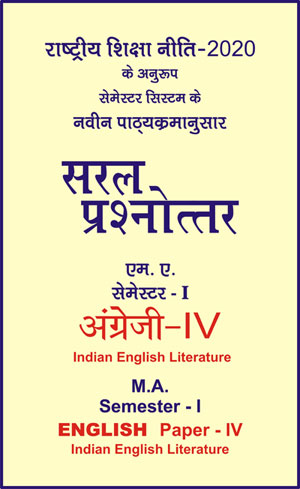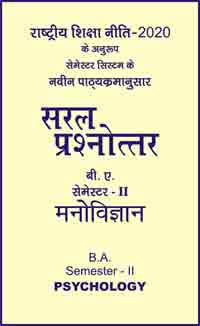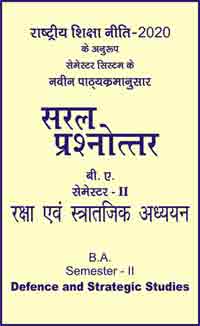|
बी ए - एम ए >> एम ए सेमेस्टर-1 - अंग्रेजी - चतुर्थ प्रश्नपत्र - इण्डियन इंगलिश लिटरेचर एम ए सेमेस्टर-1 - अंग्रेजी - चतुर्थ प्रश्नपत्र - इण्डियन इंगलिश लिटरेचरसरल प्रश्नोत्तर समूह
|
5 पाठक हैं |
|||||||
एम ए सेमेस्टर-1 - अंग्रेजी - चतुर्थ प्रश्नपत्र - इण्डियन इंगलिश लिटरेचर
Question- Shashi Deshpande's craft as a novelist a study with special reference to 'That long Silence'
Or
Shashi Deshpande as a Novelist.
Answer -
Shashi Deshpande is a well known name in the field of Indian literature. She is one of the prominent contemporary women writers in India writing in English. She has created ripples in the society of male domination by taking women as women seriously in her novels. She takes us inside the consciousness of her women characters to present their plight, fears, dilemmas, contradictions and ambitions.
Shashi Deshpande emerged on the Indian fictional scene in the 1970s. She has nevertheless created a place for herself in the galaxy of Indian women novelist in English. She excels in projecting a realistic picture of the middle class educated woman who, although financially independents, is still facing the problems of adjustment between idealism and pragmatism. She is almost in comparable for her portrayal of Indian middle class women with their turmoil's convulsions, frustrations, endurance, and "That long silence' with has been their lot for many centuries. Her novels are mainly based on the lives of women and their problems particularly in the Indian context for this reason, she has been labelled a "Feminist". She explored the realities behind the silence of women. She raised her voice against torment on women and also created mass awareness in the matter through her writings. Her books are translated into several Indian languages. Her novels are deeply rooted in India, the character settings and the conflicts are inherently Indian.
Shashi Deshpande is a leading women novelist in the Indian Literary Horizon with eight novels, four books for children, over eighty short stories and a screen play to her credit. She has won the prestigious Sahitya Academy Award for her fifth novel "That Long Silence' in 1989, she was awarded Padma Shri in 2009. In the context of the contemporary Indian writing in English. Shashi Deshpande is the confident voice, who explores individual and universal female psyche. She has gained reputation as a serious writer with tremendous potential. Most of her protagonist are women who are educated and exposed to western ideas. Women of the present day society stand on the threshhold of social change in an enviable position. They are intensely aware of the injustice heaped on them. Unlike their counterparts a generation ago. However, Shashi Deshpande does not believe that women are inferior beings who must remain passive and submissive. This awakening of the woman's consciousness as portrayed by Shashi Deshpande in her novels deserves the extent of articulation of a woman's point of view which needs to be assessed from a new perspective.
Shashi Deshpande uses first person narrative to register women's protest against the male dominated society in the novel "That long silence'. She uses double narratives in "The Dark Holds No Terrors' to give a realistic portrayal of Saru's innerself. 'Roots and Shadows', her first novel depicts the agony and suffocation experienced by the protagonist Indu in a male dominated and tradition-bound society "The Dark Holds No Terrors,' her second novel, is all about male ego where in the male refuses to play a second fiddle role in marriage.
"That Long Silence' is about self doubts and fears which Jaya under goes till she affirms herself. "The Binding Vine' deals with the personal tragedy of the protagonist Urmi to focus attention on victims like Kalpana and Mira, victim of man's lust and woman's helplessness. In 'A Matter of Time', Deshpande for the first time enters into the world of metaphysical philosophy. It is about three women from three generations of the same family and the way they cope with the tragedy that overwhelms them.
In "That Long Silence', Jaya under goes great mental trauma because she has refused to go into hiding with her husband as an enquiry against his financial irregularities is on. Like the mythological character Gandhari, she kept her eyes shut to her husband's illegal earning at office. Even her journalistic writings are circumscribed by her husband's likes and dislikes. Finally she is able to evaluate her expectations of life. After having rejected traditional role models. Deshpande's protagonists display great strength and courage in evolving, as their own role models as per the requirement of their social mileau. Her characters go through a process of self examination before they reach self actualization. Thus Shashi Deshpande has been successful in creating strong women protagonists who refuse to get crushed under the weight of their personal tragedies and face life with great courage and strength. Comparatively, they appear to more life- like and more akin to the educated, middle class, urban indian woman of today.
Speaking of the narrative technique in That Long Silence,' Shashi Deshpande avoids the simple technique of straight forward narration in the novel. She employs the flash back method instead to draw her readers attention. The first chapter deals with the present but the later chapters are more anachronic with the final chapter ending in the present. Critic Shama Futehally writes." "It is a device which is useful either when some element of suspense is indeed. For this novel chronologically charity is essential as the reader already has to cope with an abundance of characters and their complex interactions."
"That Long Silence' is very close to real life experience and achieves its credibility from the fact that the protagonist Jaya is well educated person possessing a literary sensitivity corresponding with her fictional role. The Sahitya Academy Award winning novel is about Jaya's hopes, fears, aspirations, frustrations and later triumph in life. Critic Y.S. Sunita Reddy observes; "The narrative with its slow unknotting of memories and unravelling of the soul is like an interior monologue quite similar to the stream of consciousness technique employed by Virginia Woolf."
Shashi Deshpande's best work is "That long Silence'. The narrator Jaya an upper middle-class housewife with two tenage children, is forced to take stock of her life when her husband is suspected of fraud. They move into a small flat in a poorer locality of Bombay, giving up their luxurious house. The novel reveals the hollowness of modern indian life where success is seen as convenient arranged marriage to an upwardly middle husband with the children studying in "good" schools. The repititiveness and sheer drabness of the life of a women with material comforts is vividly represented "the glassware that had to sparkle, the furniture and curious that had to be kept spotless and dust free, and those clothes, God, all these never ending piles of clothes that had to be washed and ironed, so that they could be worn and washed and ironed once again" [That Long Silence] 57"
Though, she is a writer, Jaya has not achieved true self expression. There is something almost suffocating about the narrowness of the narrator's life.
The novel contains nothing outside the narrator's narrow abmit. India's tradition and philosophy have no place here, we get a glimpse of Hinduism in the numerous fasts observed by women for the well being of husbands, sons or brothers. Jaya's irritation of such sexist rituals is palpable. It is clear that she feels strongly about the ill-treatment of the girl-child in India. The only reference to India's "glorious" part is in Jaya's comment, that in Sanskrit drama, the women did not speak Sanskrit. They were confined to Prakrit, a .less polished language, imposing a kind of silence on them. In spite of her English education, Jaya is like the other women in the novel, such as the half crazed Kusum, a distant relative, or Jeeja, their poor maid servant. They are all trapped in their own self created silence and are incapable of breaking away from the supportive yet stifling extended family.
In "That Long Silence," Deshpande raises the strong voice of protest against the male dominated Indian Society and against man made rules and conventions 'That long Silence' is a first person narrative; the story is unfolded by Jaya, ironically again symbolizing victory, while in the actual life situation, she is supposed to lead a traditional, passive life like; "Sita following her husband, Draupadi, stoically sharing her husband's travails... [That Long Silence]"11.
She refuses these role models because in modern life these references are simply allusions of the past with no relevance to the present while these legendry women followed their husbands willingly, Jaya is accompanying Mohan everywhere because of compulsion. There is a frank, even brutal, realization of this evil necessity of her conjugal life. "Two bullocks yoked. together it is more comfortable for them to move in the same directions. To go in different directions would be painful and what animal would voluntarily choose pain?" [That Long Silence 12]"
Jaya, the protagonist is the very early life, realizes that 'girl child' is her first problem. The preference shown to the male children is because they are permanent members of the family and are inheritors of the family name. The novel also interrogates the nature of the relationship between the narrator and her husband and the disposition of their married life. Their relationship is affected adversely by their incapability to understand each other. Due to lack of communication the growing 'silence' between them, their marital life grows unsteady and dismal. For the first time, Jaya feels a strange emotion of anger in the unjustified accusation by Mohan that he has taken bribe for her and her children. The very idea of "being a partner in the Crime and ally, when she has no role to play in the whole affair is revolting (That Long Silence 31) But this anger transformed into a 'long silence because for Jaya 'Silence and surrender is the real strength of an Indian woman. Shashi Deshpande has not portrayed Jaya as a feminist character. Jaya hovers between submission and assertion, the former rather a more dominant note in her character. But the repeated allegations and accusations of her husband compel her to react sharply. She (Jaya) ones lells kamat (her neighbour) * .......no women can be angry. Have you ever heard of an angry young woman'.........A woman can never be angry, she can only be neurotic, hysterical, frustrated* (That Long Silence 147). There are three district phrases of feminism. The early means imitation of role models, Jaya has already crossed that limit. The first phase of imitation is followed by angry and protest, the major thrust of the novel is the depiction of this second phase in the life of Jaya. Whenever she looks back on her life, there is hardly any sense of nostalgia or yearning for the past; it is much more a feeling of suppressed angry which can burst out any time. The last phase of feminism that of articulation and assertain are only hinted in this novel as one of the future possibilities for Jaya.
The whole novel is a preparation for that articulation which will break her long silence. The reader is given sufficient hint that she is going to break her passivity; even Jaya asserts "will have to erase the silence between us, but the actual drama is postponed to the future" (That long silence 192). Having realized her position, Jaya would not accept the earlier image of a pair of bullocks yoked together, signaling a loveless couple. She comes to realize that life can always be made possible. The earlier impulsive Jaya becomes a mature women, and with her realization, shadow that befall between wife and husband tends to disappear.
The novelist tries to establish that it is not only the patriarchal set up which is responsible for the women's condition in the Indian society. The responsibility also lies within the victim to refuse, to raise a voice and to achieve the goal. The novel also traces the growth of the protagonist from a state of weakness, feeling of failure to that of relaxation. She accomplishes this through self assessment and self criticism. Shashi Deshpande told Joel Kuortti in an interview.
The long silence is a hysterical novel in the sense that inside of me I was kind of screaming, but when it came out as you said, one steps back from that screaming self and one says, look Jaya is very analytical, there is no point at which she gives way to her emotions or self pity or anything, Throughout she is analyzing herself, her life her relationship, and I think that is how it has been for me. I think it was really the culmination of the anger and all the repression, every thing came out in that long silence (sharma 55).
Shashi Deshpande's "That Long Silence' is an expression of the silence of the modern indian wife. Although many women writers tried hand at expressing this long silence that had turned woman into non entities, they could only provide psychological depths to their characters. They neither created unreal sentimental romances or finally succumbed to the temptation at mouthing feminist ideology. But Shashi Deshpande success lies in her representation of real life experience. She realistically depicts the inner conflicts of Jaya and her quest for the self or identity. Jaya represents half the humanity. The novel sustains it's credibility from the fact that Jaya is a convent educated English speaking lady with a literary taste. It portrays the conflict raging between the narrator's spilt self; the writer and the housewife. About "That Long Silence'.
"And then I wrote That long silence' almost entirely a woman's novel nevertheless, a book about the silencing of the one half of the humanity. A lifetime of introspection went into this novel, the one closest to me personality; the thinking and ideas in this are closest to my own."[Prasad 58]"
|
|||||
- Question- Write about Post-Colonial Indian writings in English Literature?
- Question- What is Postmordanism in English Literature?
- Question- Write an essay Postmoderism's influence of Indian writing in High Ab Han English Literature?
- Question- What is Dalit Literature?
- Question- Write about Dalit's voice: A voice from the Margin?
- Question- Write the development of Indian English Poetry, since the 1980s.
- Question- What is experimental Theatre?
- Question- What is Indians in Indian "English Literature”?
- Question- Define the term 'Indian English Literature'?
- Question- What is contemporary poetry in English Literature?
- Question- What is India drama in English Literature?
- Question- What is experimental Poetry?
- Question- Write about the origin of structuralism and Post-structuralism.
- Question- Write the theory of Post-modernism.
- Question- What do understand by the post-colonialism?
- Question- Write the influence of Postmoderanism on English Literature?
- Question- Write about the Renaissance in India and other essays on Indian culture.
- Question- Write about Renaissance in India and the nature of India culture as explicated by Sri Aurobindo.
- Question- Who is Sri Aurobindo? Give an introduction of him.
- Question- What are the ideas on Indian culture of Aurobindo, given in his essay 'Indian culture and external influence'?
- Question- Write an introduction of Dr. Sarvepalli Radhakrishnan. with whole life.
- Question- What is Idealism?
- Question- Write an introduction of 'An Idealist View of Life' by Radhakrishnan.
- Question- How does an idealist view life?
- Question- Write an introduction of Nirad C. Chaudhari.
- Question- Write the background of the book 'A passage to England' by C. Chaudhari.
- Question- Write a summary of 'A Passage to England' with giving an introduction of book. and describe 'The English Scene'.
- Question- What is the purpose of Chaudhari to write 'A Passage to England?
- Question- Write a short note on the life and works of Mrs. Meenakshi Mukherjee.
- Question- What do you know about The Perishable Empire : Essays on Indian writing in English' by Meenakshi Mukherjee?
- Question- Critically appreciate the poem The Harp of India'.
- Question- Give a brief life sketch of Henry Derozio.
- Question- Write a short note on Young Bengal Movement.
- Question- Provide a brief background of the poem 'The Harp of India'.
- Question- What do you know about part 1 of the poem?
- Question- What do you know about part 2 of the poem?
- Question- What impact has the prevailing conditions of the times made on India in the poem 'The Harp of India'?
- Question- Expalin with reference to the context any two of the following passeges.
- Question- Write a critical appreciation of 'Love Poem for a Wife' by A. K. Ramanujan.
- Question- In which style 'Love poem for a wife' is written? Explain.
- Question- Expalin with reference to the context any two of the following passeges.
- Question- Who is R. Parthasarathy? Write about his life and career.
- Question- What is the summary of the poem 'Exile from Homecoming"?
- Question- Write a Critical appreciation of the poem 'Exile From Homecoming'.
- Question- What has happened to poetry and why?
- Question- Why does the speaker recommend newspapers?
- Question- What is the introduction of 'Exile From Homecoming'?
- Question- Expalin with reference to the context any two of the following passeges.
- Question- What is the introduction of the poem 'Palanquin-Bearer'?
- Question- What is the critical appreciation of "The Palanquin Bearers'?
- Question- Write life and works of Sarojini Naidu.
- Question- What is the message in Palanquin Bearers by Sarojini Naidu?
- Question- What is the mood, tone and setting of the palanquin Bearers?
- Question- What is the Summary of the poem The Palanquin Bearers'?
- Question- Expalin with reference to the context following passege.
- Question- Write life and works of Shiv K. Kumar.
- Question- Write a note on Shiv K. Kumar as a poet.
- Question- Write a critical appreciation of the poem, 'Pilgrimage'.
- Question- Expalin with reference to the context following passege.
- Question- What do you know about Dom Moraes?
- Question- What is the summary of the poem "Bells for William Wordsworth".
- Question- Expalin with reference to the context following passege.
- Question- What is the summary of the poem Tribute to Papa' by Mamta Kalia?
- Question- Mamta Kalia's poem Tribut to Papa' is quest for an identy. Write about it?
- Question- Expalin with reference to the context following passege.
- Question- Explain how myth and symbolism are integral parts of Raja Rao's fictional act in Kanthapura.
- Question- What are the main features of Raja Rao's narrative technique in Kanthapura?
- Question- The three levels of action in Kanthapura-political, social and religious are all related to a unified concept of India. Discuss the structure of the novel in the light of the statement.
- Question- Provide a summary of the novel 'Kanthapura'.
- Question- What are the important themes one can find in Kanthapura?
- Question- Place Raja Rao in the context of the evolution of the Indian writing in English.
- Question- What do you know about the historical and political background of Kanthapura?
- Question- How deep and wide is the impact of Gandhi's personality and his thought on the theme of Kanthapura?
- Question- What do you know about Kanthapura and its people?
- Question- What is the significance of the Skeffington Coffee Estate in the overall account of the village in Kanthapura?
- Question- What are those qualities that go into the making of Moorthy, the central figure in Kanthapura?
- Question- What do you think of the women characters in Kanthapura? What is their role in the action of the novel?
- Question- How successful is Moorthy in leading his followers in the Satyagraha movement of the village?
- Question- Write a short essay on 'Considerations of Caste' in Kanthapura.
- Question- How successful is Achakka, the narrator in her attempt to tell the story of her village in the context of the Satyagraha movement?
- Question- Comment on some of the male character - other than Moorthy in Kanthapura.
- Question- What are some important themes in the novel 'The Guide'?
- Question- Provide a detailed character sketch of Raju (The Guide).
- Question- Can The Guide' be called a picaresque novel?
- Question- Comment on the narrative technique in "The Guide'.
- Question- Unravel the various aspects of Rosie's character in the light of the novel.
- Question- Sum up the literary elements found in the novel.
- Question- How is the concept of universality explored in the novel?
- Question- Write a short note on R.K. Narayan.
- Question- What do you know about Raju from 'The Guide'?
- Question- Give a brief character sketch of Rosie.
- Question- What importance does the town 'Malgudi' carry in most of the novel of R.K. Narayan?
- Question- Give a brief character sketch of Marco.
- Question- Write a brief character sketch of Velan.
- Question- How is title of the novel 'The Guide' appropriate?
- Question- Critically analyze the novel The Guide.'
- Question- Is Raju a transformed man by the end of the novel?
- Question- Is Velan a mere fool or a major accessory to Raju's transformation?
- Question- What roles do dharma and Karma play in the text?
- Question- What are the some important metaphors we come across after reading in the novel?
- Question- Write about the whole life of Shashi Deshpande with works.
- Question- Shashi Deshpande's craft as a novelist a study with special reference to 'That long Silence'
- Question- What is theme of the novel 'That Long Silence'?
- Question- Describe Jaya's Quest for self in "That Long Silence' by Shashi Deshpande.
- Question- What do you mean by the title of the novel 'That Long Silence'?
- Question- What is the introduction of Shashi Deshpande?
- Question- What is 'That Long Silence' about?
- Question- What is the relationship between Jaya and Mohan in the "That Long Silence'?
- Question- Who always reminds Jaya That husband is like sheltering tree?
- Question- Who is Kamat in the novel 'That Long Silence'?
- Question- What is the Indroduction of Firdaus Kanga's 'Trying to Grow'?
- Question- Analysis of Trying to Grow' by Firdaus Kanga.
- Question- Describe of Parsi Community in "Trying to Grow' by Firdaus Kanga?
- Question- Who is Firdaus Kanga?
- Question- What is the major achievement of 'Firdaus Kanga'?
- Question- Write about the sixth Happiness, BFI/BBC Film in 'Trying to Grow' by Firdaus Kanga.
- Question- Write life and works of Arundhati Roy.
- Question- How has Arundhati Roy projected the illicit or incestuous relations in 'The God of Small Things'?
- Question- Evaluate The God of Small Things' as a tale of confrontation as its theme.
- Question- Give a brief character sketch of Estha and Rahel.
- Question- Why did the relationship of Ammu and Velutha came to an abrup end?
- Question- Relate the atrocities faced by Ammu all her life and her insignificant end?
- Question- Describe the Roy's use of symbols and images in her novel.
- Question- Write the life and works of Ilavenil Meena Kandasamy.
- Question- What is the introduction of the novel 'When I Hit You?
- Question- Describe the portrayal of domestic violence in 'When I Hit You?
- Question- Write about The Feminism in 'When I Hit You?
- Question- What is the summary of the story "Two Lady Rams"?
- Question- Write a note on Indian-ness in "Two Lady Rams' by Mulk Raj Anand.
- Question- What is the significance of the Title 'Two Lady Rams'?
- Question- Who was the first wife of Lalla Jhinda Ram?
- Question- Who is Lalla Jhinda Ram?
- Question- Analyse the story "Two Lady Rams'.
- Question- Write about the life of Salman Rushdie.
- Question- Write about the carrer of Salman Rushdie.
- Question- Write the summary of the story "Free Radio" by Salman Rushdie.
- Question- Who was the narrator in the short story "The Free Radio'?
- Question- Justify the title of the story "The Free Radio'.
- Question- Who is Ramani and what is the role of Ramani in this story "The Free Radio'?
- Question- What is the introduction of the story 'The Free Radio'?
- Question- Why is the narrator so much concerned for Ramani?
- Question- What does the Free Radio Symbolize in the story free radio'?
- Question- Write about the sexism in the story 'The Free Radio'?
- Question- Write a summary of the story 'The Intrusion'.
- Question- Analyse the story "The Intrusion' as a quest for identity
- Question- Write about the human predicament and emotional suffocation in Shashi Deshpande's short story "The Intrusion'.
- Question- Write the justification of the title "The Intrusion.'
- Question- What does the wife want in the story "The Intrusion'?
- Question- Who is the intruder in the story 'The Intrusion'?
- Question- What is the summary of the story 'Diamond Dust' by Anita Desai?
- Question- Write about the themes of 'Diamond Dust' by Anita Desai.
- Question- Who is Mr. Das in the Story 'Diamond Dust'?
- Question- What is the role of Mrs Sheila Das in 'Diamond Dust?
- Question- Who is Diamond in the story 'Diamond Dust'?
- Question- Attempt a critical appreciation of Vijay Tendulkar's play, Silence! The Court is in Session.
- Question- Attempt an essay on Tendulkar's delineation of women in his play, silence! The court is in Session.
- Question- Discuss Tendulkar's humour satire and irony in 'Silence! The Court is in Session.'
- Question- Justify the title of Vijay Tendulkar's play, Silence! The Court is in Session.
- Question- Write a short note on the role of Sukhatme in the mock-trial in Tendulkar's play, Silence! The Court is in Session.
- Question- Wite the character sketch's of Mr. Kashikar.
- Question- Give a short account of Miss Benare as a teacher.
- Question- What verdict does Kashikar give in Benare's case?
- Question- Write a short note on Balu Rokde.
- Question- Bring out the significance of prof. Damle in Silence! The Court is in Session.
- Question- How does Tendulkar's play, Silence ! reveal society's partiality towards woman?
- Question- Life and work of Grish Karnad.
- Question- What is the introduction of 'The Fire and the Rain'?
- Question- Discuss the central themes of Girish Karnad's play, 'The Fire and the Rains'.
- Question- Write a character sketch of Yavakri.
- Question- Write a critical note on Paravasu-Vishakha relationship.
- Question- Write a character sketch Raibhya.
- Question- Comment on the significance of the role of the Actor Manager in "The Fire and the Rain'.
- Question- Wha is the theme of 'The Fire and The Rain'?
- Question- Who is Raibhya in "The Fire and The Rain'?
- Question- Who is Andhaka in the 'The Fire and The Rain'?
- Question- Who is Arvasu?
- Question- Write a note on the life and works of Manjula Padmanabhan.
- Question- Write the summary of 'Harvest' by Manjula Padamanabhan.
- Question- Write a note on Themes and Techniques in Manjula Padmanabhan's plays.
- Question- Who is the man character of the play 'Harvest'?
- Question- Who is Jaya in the story 'Harvest'?
- Question- How does Ginni control Om and his family?
- Question- Who is Ginni in the play 'Harvest'?
- Question- Discuss the theme of exploitation in the play 'Harvest'.














